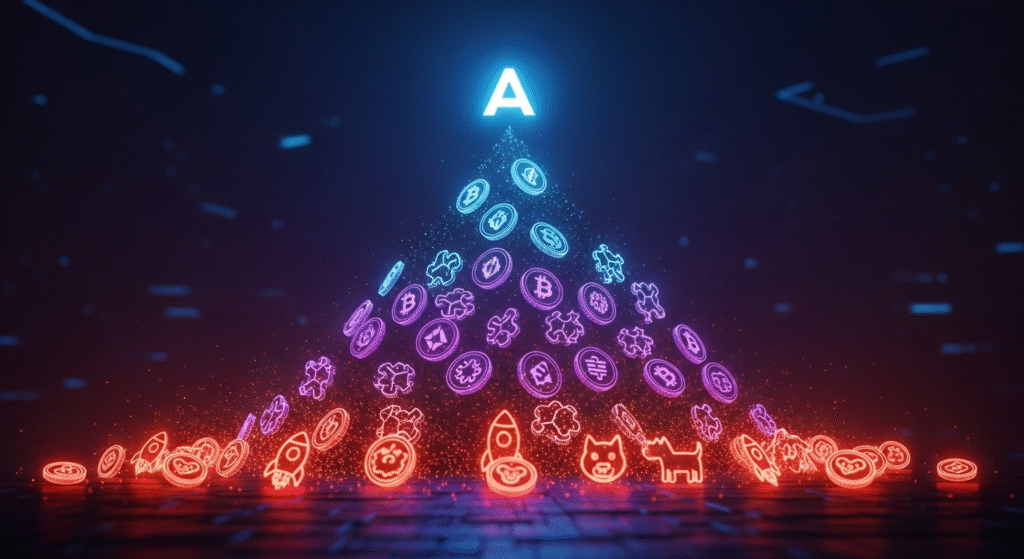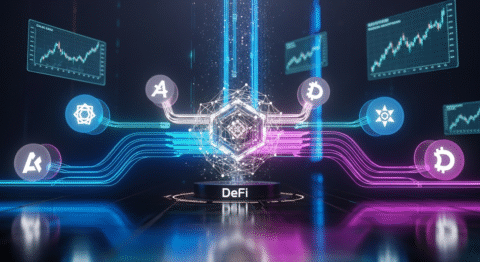Introduction
Missing out on altcoin gains? Learn Market Cap secrets for meme coin & altcoin profits. Get actionable crypto insights. Discover your potential. The cryptocurrency landscape is a rapidly evolving ecosystem, constantly presenting new opportunities and challenges. While Bitcoin and Ethereum often dominate headlines, the burgeoning world of altcoins and the electrifying realm of meme coins offer unique avenues for potential profit. But how do you navigate these volatile waters and identify projects with genuine growth potential? Understanding a project’s Market Cap is your compass.
The Current Crypto Climate: A Surge of Altcoin & Meme Coin Interest
The broader cryptocurrency market has demonstrated impressive resilience and innovation in recent times. Following periods of significant correction, we’re observing a renewed surge of interest, particularly in the altcoin and meme coin sectors. Data from CoinMarketCap reveals a significant uptick in trading volume and new project launches. For instance, in the last quarter, altcoins collectively saw a rise in their total market dominance, indicating a potential shift in investor sentiment away from purely Bitcoin-centric portfolios. Meme coins, once relegated to niche online communities, are now significant players, with some experiencing explosive growth and attracting mainstream attention. This vibrant activity underscores the importance of understanding the fundamental metrics that drive value, and Market Cap is paramount among them.

The Core Concept: How Market Cap Actually Works
Understanding the Market Cap of a cryptocurrency is fundamental to assessing its potential and its place within the broader market. It’s not just a number; it’s a reflection of market perception, adoption, and perceived intrinsic value.
What Are Altcoins & Meme Coins?
Before diving deeper into Market Cap, let’s clarify what we’re discussing.
- Altcoins: Short for “alternative coins,” altcoins are any cryptocurrencies other than Bitcoin. They emerged as a response to Bitcoin’s perceived limitations or to offer novel functionalities. Altcoins can range from highly sophisticated, utility-driven projects utilizing advanced blockchain technology to simpler, speculative ventures. Examples include Ethereum (ETH), Solana (SOL), Cardano (ADA), and thousands more, each with its own unique purpose, consensus mechanism, and technological stack.
- Meme Coins: Meme coins are cryptocurrencies that are often inspired by internet memes, jokes, or popular culture references. While some meme coins have foundational technology and utility, many are primarily driven by community hype, social media trends, and speculative trading. Dogecoin (DOGE) and Shiba Inu (SHIB) are prime examples, demonstrating how strong community engagement and viral marketing can create significant market momentum, often independent of traditional utility. Their Market Cap can fluctuate wildly based on social sentiment.
Key Components & Technologies Behind Crypto Valuations
The value and, by extension, the Market Cap of cryptocurrencies are underpinned by various technological and economic factors.
- Blockchain Technology: The foundational distributed ledger technology that secures transactions, ensures transparency, and enables decentralization for most cryptocurrencies. Different blockchains offer varying transaction speeds, scalability, and security features, directly impacting the utility and adoption potential of the tokens built on them.
- Smart Contracts: Self-executing contracts with the terms of the agreement directly written into code. They enable decentralized applications (dApps), decentralized finance (DeFi) protocols, and unique token functionalities, adding layers of utility and value that contribute to a project’s Market Cap.
- Decentralized Finance (DeFi): A burgeoning sector of cryptocurrencies aiming to recreate traditional financial services (lending, borrowing, trading) in a decentralized manner, without intermediaries. Projects in DeFi often have complex tokenomics tied to network participation and governance, significantly influencing their Market Cap.
- Tokenomics: The economic design of a cryptocurrency, encompassing its supply (total, circulating, maximum), distribution mechanisms, utility within its ecosystem, and consensus model. Strong tokenomics are crucial for long-term value and a sustainable Market Cap.
The Data-Driven Perspective: Illuminating Market Cap Realities
When we talk about Market Cap, we’re talking about a quantitative measure that helps investors gauge the relative size and potential valuation of a cryptocurrency. It’s a crucial metric for understanding where a project stands in the vast crypto universe.
Market Data & Trends: Tracking Altcoin & Meme Coin Performance
The cryptocurrency market is dynamic, and robust data analysis is key to understanding trends.
- Dominance Charts: Bitcoin’s dominance has historically influenced altcoin performance. When Bitcoin’s dominance falls, it often signals a period where capital flows into altcoins, potentially boosting their Market Cap. Conversely, when Bitcoin dominance rises, capital tends to flow back to it, potentially dampening altcoin enthusiasm.
- Trading Volume: High trading volume for an altcoin or meme coin often indicates strong market interest and liquidity, which can contribute to a stable or growing Market Cap. A sudden spike in volume, however, can also signal speculative frenzy or a pump-and-dump scheme, making context crucial.
- Total Value Locked (TVL) in DeFi: For DeFi tokens, TVL is a critical indicator. It represents the total value of assets locked in smart contracts of a protocol. A rising TVL suggests increasing adoption and utility of the underlying token, positively impacting its Market Cap.
- Social Sentiment Analysis: For meme coins especially, social media buzz (Twitter mentions, Reddit activity, Telegram engagement) can directly correlate with price action and Market Cap surges. However, this is a high-risk indicator due to its speculative nature.
Tokenomics & Market Health: The Backbone of Value
Understanding a project’s tokenomics is essential for a data-driven assessment of its potential Market Cap and long-term viability.
- Circulating Supply vs. Total Supply: The circulating supply represents the tokens currently available to the public. The total supply includes all tokens that will ever be created. The difference can indicate future inflation or locked tokens. A rapidly inflating supply can dilute the value per coin, putting downward pressure on Market Cap if demand doesn’t keep pace.
- Market Capitalization Calculation: The core formula for Market Cap is straightforward:
Market Cap = Circulating Supply × Current Price per Coin
This simple equation provides a snapshot of the entire value of a cryptocurrency as perceived by the market at a given time. For instance, if a coin has 100 million coins circulating and each coin is trading at $0.50, its Market Cap is $50 million. - Fully Diluted Valuation (FDV): FDV is calculated as:
FDV = Total Supply × Current Price per Coin
FDV gives a theoretical maximum value if all tokens were in circulation. Comparing Market Cap to FDV can reveal potential future dilution. A large difference between the two might suggest significant inflation ahead. - Demand Drivers & Utility: A healthy Market Cap is supported by genuine demand, driven by the token’s utility within its ecosystem, governance rights, staking rewards, or as a medium of exchange. Meme coins often lack this robust utility, with their Market Cap being more susceptible to speculative demand.
- Distribution: How tokens are distributed among founders, early investors, and the public can impact price stability and decentralization. A highly concentrated distribution can lead to significant selling pressure if early holders decide to cash out, affecting the Market Cap.
Risks, Challenges & Competition: Navigating the Altcoin Maze
While the potential for profit in altcoins and meme coins is significant, it’s imperative to acknowledge the inherent risks and challenges involved. Understanding how a project stacks up against its competitors is a crucial part of this assessment.
Risks of Altcoins and Meme Coins
The allure of high returns in the altcoin and meme coin space often comes with substantial risks:
- Extreme Volatility: Both altcoins and meme coins are notoriously volatile. Prices can surge by hundreds or thousands of percent in days and plummet just as quickly. This makes them high-risk investments, unsuitable for those with low risk tolerance.
- Lack of Intrinsic Value & Utility: Many meme coins, and some altcoins, lack a clear use case or underlying technology that would justify sustained value. Their price action is often driven purely by speculation and community sentiment, making their Market Cap fragile.
- Security Vulnerabilities: Newer or less established altcoins may be susceptible to smart contract exploits, hacks, or other security breaches, leading to substantial losses and a collapse in their Market Cap.
- Regulatory Uncertainty: The regulatory landscape for cryptocurrencies is still evolving globally. New regulations could impact the legality or tradability of certain altcoins or meme coins, affecting their market accessibility and Market Cap.
- “Pump and Dump” Schemes: The speculative nature of these markets makes them fertile ground for coordinated “pump and dump” schemes, where a group artificially inflates the price before selling off their holdings, leaving other investors with significant losses.
How Altcoins & Meme Coins Stack Up Against Competitors?
To effectively evaluate an altcoin’s or meme coin’s potential, it’s vital to compare it to its peers. Let’s use a hypothetical example to illustrate:
| Feature | Project Alpha (Utility Altcoin) | Project Beta (Meme Coin) | Bitcoin (BTC) | Ethereum (ETH) |
|---|---|---|---|---|
| Primary Purpose | Decentralized data storage and AI training | Community engagement, speculative trading | Digital Gold, store of value | Smart contracts, dApp platform, DeFi infrastructure |
| Market Cap | $500 Million | $100 Million | $1.3 Trillion | $400 Billion |
| Technology | Advanced encrypted blockchain, AI integration | Standard blockchain, fungible token | Proof-of-Work (PoW), robust security | Proof-of-Stake (PoS), smart contract capabilities |
| Utility | Data storage fees, AI computation rewards, governance | Primarily community-driven hype; developing staking | Medium of exchange, store of value | Gas fees for transactions, DeFi development, NFTs |
| Tokenomics | Capped supply, deflationary mechanisms, staking rewards | High inflation, initially unlimited supply (now capped) | Capped supply (21M), halving events | No hard cap, but controlled issuance via staking |
| Community | Active developers, enterprise partnerships, user base | Large, vocal social media presence, high retail interest | Large, diverse global user base | Huge developer community, extensive dApp ecosystem |
| Risk Level | Medium to High (technology adoption risk) | Very High (speculative, utility dependent) | Medium (market volatility, regulatory scrutiny) | Medium (scalability challenges, competition) |
| Liquidity | Good on major exchanges | Moderate; prone to manipulation during low volume | Very High | Very High |
This table highlights key differences. Project Alpha, despite a smaller Market Cap than Ethereum or Bitcoin, possesses strong utility and tokenomics that could drive future growth. Project Beta’s Market Cap is largely driven by sentiment, making it inherently more speculative. Understanding these distinctions is crucial for informed investment decisions. Analyzing the Altcoin Cap within specific sectors or the overall meme coin market can also provide valuable context.
The Future Outlook: What’s Next?
The trajectory of altcoins and meme coins remains a topic of intense debate and speculation. However, several key trends are likely to shape their future and influence their Market Cap:
What’s Next for Altcoins?
- Increased Utility and Adoption: The narrative is shifting from purely speculative altcoins to those offering tangible solutions and real-world use cases in areas like DeFi, NFTs, supply chain management, and Web3 infrastructure. Projects with strong technological foundations and clear adoption pathways are likely to see their Market Cap grow organically.
- Layer-2 Scaling Solutions: As blockchain scalability becomes paramount, Layer-2 solutions for major smart contract platforms like Ethereum are gaining traction. Tokens associated with these scaling technologies could experience significant growth.
- Interoperability: The ability for different blockchains to communicate and share data seamlessly is a crucial development. Projects focused on interoperability solutions are well-positioned to capture significant value.
- Regulatory Clarity: As governments worldwide work towards clearer regulations, this could provide both opportunities (legitimization, institutional adoption) and challenges (restrictions on certain types of tokens) for altcoins.
What’s Next for Meme Coins?
- Evolution Beyond Hype: While hype remains a primary driver, we may see some meme coins attempting to integrate more substantial utility, such as decentralized governance, community-driven projects, or integration into gaming and metaverse platforms. This could lend more stability to their Market Cap.
- Further Mainstream Integration: As meme coins gain broader recognition, they might become more integrated into mainstream financial discussions and even some investment portfolios, albeit with significant caution.
- Increased Scrutiny: The speculative and often volatile nature of meme coins will likely continue to attract scrutiny from regulators and financial watchdogs, potentially leading to greater caution for investors.
The inherent volatility means that while a meme coin’s Market Cap can skyrocket overnight, it can also evaporate just as quickly. For altcoins with solid fundamentals, however, the potential for long-term growth driven by technological innovation and adoption is considerable.
Conclusion: Empowering Your Crypto Journey with Market Cap Insights
Understanding Market Cap is not just an exercise in data analysis; it’s a critical tool for navigating the complex and often exhilarating world of cryptocurrencies, especially altcoins and meme coins. We’ve seen how this simple metric, derived from the circulating supply and current price, offers a fundamental glimpse into a project’s perceived value and its relative standing in the market.
From identifying potential growth opportunities in utility-driven altcoins to understanding the speculative nature of meme coins, Market Cap provides a crucial data point. Remember, a large Market Cap doesn’t automatically guarantee success, nor does a small one preclude massive growth. It must be analyzed in conjunction with tokenomics, utility, community strength, and competitive landscape.
We encourage you to continue learning and refining your approach to crypto investing. The market is constantly evolving, and staying informed is key.
What are your thoughts on the current state of altcoins and meme coins? Do you prioritize Market Cap when researching new projects? Share your experiences and insights in the comments below!
For more deep dives into crypto strategies, market analysis, and the secrets to unlocking your potential in this dynamic space, be sure to explore our other articles and subscribe to our newsletter for regular updates and actionable insights.
FAQs: Your Burning Questions About Market Cap Answered
1. What is the most important factor when evaluating a cryptocurrency’s Market Cap?
While Market Cap is crucial, it should never be the sole factor. Equally important are the project’s utility, tokenomics, the strength and activity of its community, the development team’s track record, and the underlying technology. For altcoins, utility and adoption are key drivers of long-term Market Cap growth. For meme coins, community sentiment and speculative momentum are often the primary drivers, making them inherently riskier.
2. Can a cryptocurrency with a low Market Cap make me rich?
Yes, it’s possible, but it comes with extremely high risk. Low Market Cap coins are often early-stage projects or highly speculative assets. While they have the potential for exponential growth (e.g., a 100x increase from a small base Market Cap can still be significant), they are also far more susceptible to complete failure or manipulation than larger, more established cryptocurrencies.
3. How does Market Cap differ from Market Dominance?
Market Cap refers to the total value of a single cryptocurrency (Circulating Supply × Price). Market Dominance, on the other hand, refers to a cryptocurrency’s Market Cap as a percentage of the total cryptocurrency market’s Market Cap. For example, Bitcoin’s market dominance indicates its overall share of the entire crypto market’s value.
4. When should I be wary of a cryptocurrency with a high Market Cap?
A high Market Cap doesn’t automatically mean a project is safe or guaranteed to succeed. Be wary if:
- The Market Cap seems disproportionately high compared to the project’s actual utility or adoption.
- The tokenomics suggest massive future inflation that could dilute current holders.
- The majority of ownership is concentrated in a few wallets, posing a risk of large sell-offs.
- The price has surged purely on hype with no accompanying development or utility advancements.
5. How can I find the Market Cap for any cryptocurrency?
You can easily find the Market Cap for virtually any cryptocurrency on popular crypto data aggregators like CoinMarketCap, CoinGecko, or TradingView. These platforms provide real-time data, charts, and historical information for thousands of digital assets.
6. Is there a specific Market Cap threshold for a “good” altcoin?
There’s no universal threshold. A “good” altcoin depends on your investment strategy and risk tolerance. For aggressive growth, you might look at smaller Market Cap altcoins with strong fundamentals, understanding the higher risk involved. For more stability, you might focus on mid-to-large cap altcoins that have established ecosystems and proven use cases. Always conduct thorough research beyond just the Market Cap.






